Rebecca Kramer-Bottiglio Brings Robotic Skins to Jeff Bezos' Elite MARS Conference
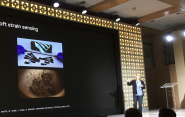
Within the span of two days, Rebecca Kramer-Bottiglio presented her technology to a high-caliber audience that included Amazon founder Jeff Bezos, traded ideas with top researchers from around the world and hobnobbed with Hollywood elite.
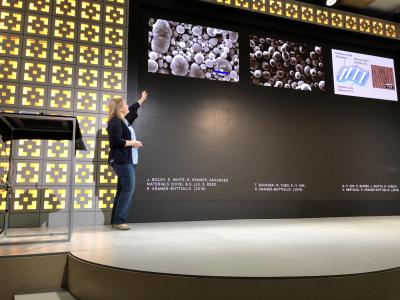 It all happened at Bezos’s MARS conference, held in this spring in Palm Springs, CA. Bezos’s annual conference (this year's was the fourth) brings together researchers from academia, start-ups, and Fortune 100 companies to present and share ideas.
It all happened at Bezos’s MARS conference, held in this spring in Palm Springs, CA. Bezos’s annual conference (this year's was the fourth) brings together researchers from academia, start-ups, and Fortune 100 companies to present and share ideas.
“The event is invitation-only and fairly secretive” said Kramer-Bottiglio, assistant professor of mechanical engineering & materials science. One of only 14 researchers selected to give a presentation at the conference, Kramer-Bottliglio focused her talk on her work with robotic skins, devices that enable users to turn everyday soft objects into robots.
The press isn’t invited, but the top-drawer attendees and cutting-edge topics have caught the public’s attention about the conference, which focuses on machine learning, automation, robotics and space (MARS). Although she has presented to audiences larger than the 180 people in attendance, none have had the Amazon founder in the front row, occasionally taking out his cell phone to take photos of her work.
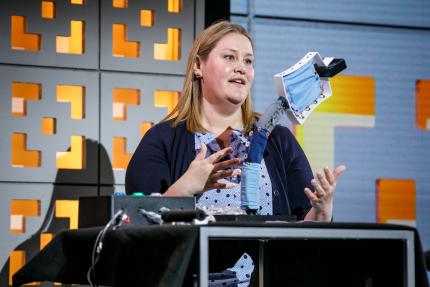
Her presentation included an onstage demonstration of the robotic skins, made from elastic sheets embedded with sensors and actuators developed in Kramer-Bottiglio’s lab. Placed on a deformable object, such as a stuffed animal or a foam tube, the skins animate these objects from their surfaces. Although they’re designed with no specific task in mind, Kramer-Bottiglio said, applications include everything from locomotion robots to grippers and wearable technologies.
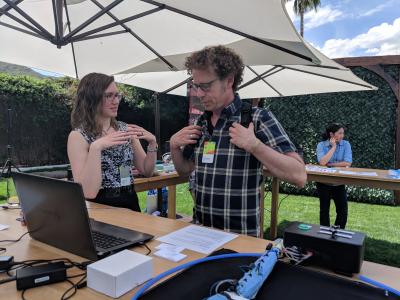 Onstage, she demonstrated a three-segment continuum manipulator, which moves much like a spine or an elephant trunk while holding an object, highlighting its advantages over rigid manipulators. She then removed one of the robotic skins from the manipulation platform and put it on another object to create an inchworm locomotion robot on-the-fly.
Onstage, she demonstrated a three-segment continuum manipulator, which moves much like a spine or an elephant trunk while holding an object, highlighting its advantages over rigid manipulators. She then removed one of the robotic skins from the manipulation platform and put it on another object to create an inchworm locomotion robot on-the-fly.
Other presenters’ projects included a flapping micro air vehicle (which flew around the room), NASA technology to measure the sun close up, and Disney’s acrobatic robots, just to name a few.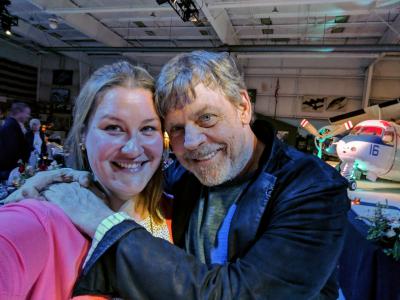
She also got in some time to compare notes with researchers from other universities, talk with numerous CEOs and get a selfie with Mark Hamill (Luke Skywalker, that is). At dinner, she philosophized about the nature of robots with “Black Swan” director Darren Aronofsky (who has a robot movie in the works). During an evening on-stage interview, the writers of the sci-fi series “The Expanse,” in attendance for the conference, pointed to the robotic skins as a technology that piqued their interest. Kramer-Bottiglio later discussed her technology with the writers, so don’t be surprised if robotic skins find their way into a storyline in the future.
The conference also featured lawn demonstrations where attendees could check out the various kinds of technologies on display during lunchtime. Visitors to the Kramer-Bottiglio station tried on a wearable posture-correcting device or used a continuum manipulator for a game that calls for robotically grasping objects and a lot of coordination.
“We also had what we called ‘the sandbox’ - a lot of robotic skins and random soft objects that people could use to design and build whatever soft robots they wanted to,” she said. Additionally, she brought some materials developed in her lab, including those for sensors and some newer ones designed for varying elasticity, stiffness, and actuator trajectory.
Accompanying Kramer-Bottiglio to the conference were Ph.D. students Jennifer Case and Dylan Shah, and postdoctoral researcher Michelle Yuen, all from Kramer-Bottiglio’s lab. Since the event was a lot more hands-on than the typical conference, Case said, she and the rest of the team stepped up their demonstration skills. “There was a lot of work prepping the demonstrations as well as getting them set up to make sure they were all working,” she said.
And there was plenty of time to talk with the other attendees and go on hikes. Case said the wide range of fields represented at the event added another twist.
“We got to see the other projects and talk to the other teams as well,” Case said. “It was a different experience because we got to spend time with people outside of our field of robotics.”
Kramer-Bottiglio’s participation was nearly a year in the making and included an Amazon team to help her prepare the talk. She said the experience was well worth the time and effort.
“The fact that my technology is on Amazon’s radar and I got the chance to put it out in front of all these prominent CEOs and researchers - I was very honored,” she said.

